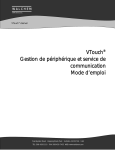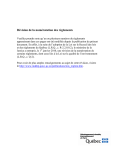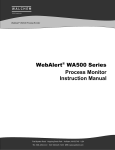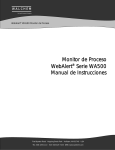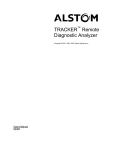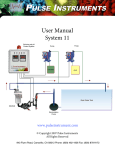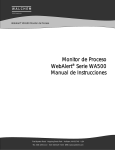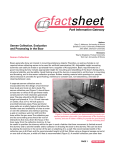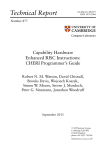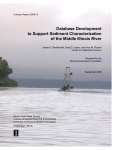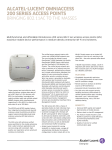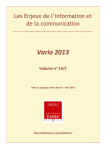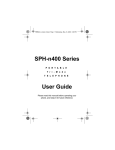Download Pollution Prevention Technology Profile Conductivity
Transcript
Pollution Prevention Technology Profile Conductivity Controls in Water Rinsing, Cooling Towers, and Boilers February 2005 Introduction The purpose of this Technology Profile is to present general information about point-of-use water monitoring for rinse tanks, boilers and cooling towers, that yield data useful for improving water use efficiency and reducing water related wastes. The following topics are covered. Opportunity Overview ............................................................................................................3 Applications and Technology Overview ..............................................................................5 Regulatory Requirements ......................................................................................................7 Installations in Rinsing, Cooling Towers and Boilers.........................................................7 Water Rinsing in Pretreatment, Finishing and Plating Operations .......................................8 Cooling Towers ..................................................................................................................10 Boilers ................................................................................................................................13 Technology Details...............................................................................................................16 Conductivity Sensors .........................................................................................................16 Temperature Compensation for Conductivity.....................................................................17 Conductivity Controls .........................................................................................................18 Establishing Conductivity Setpoints ...................................................................................18 Key Installation Requirements ...........................................................................................19 Cleaning and Calibration....................................................................................................19 Flow Control Valves ...........................................................................................................20 Data Collection and Monitoring ..........................................................................................22 Flow Meters........................................................................................................................22 Benefits of Conductivity Controls.......................................................................................23 Challenges with Installing and Using Conductivity Controls...........................................24 Costs......................................................................................................................................26 Case Studies .........................................................................................................................27 Rinsing ...............................................................................................................................27 Cooling Towers ..................................................................................................................29 Boilers ................................................................................................................................32 References ............................................................................................................................33 Acknowledgments: Thanks to Carol Sangster and boiler inspectors at Chubb Group of Insurance Co., Robin Hanks of Spirax Sarco, J. Kevin Quackenbush of Foxboro Analytical, Gil McCoy of Washington State University Energy Program, Karl DeWahl of the Minnesota Technical Assistance Program, Richard Meisenhelder and Cam Metcalf of the Kentucky Pollution Prevention Center, Matt McMullen of Nalco Company, Walchem representatives, and David Schnitta of MyronL Company, Jerry Brown of the Waste Management Research Center, and John Seymour of North Carolina Division of Pollution prevention and Environmental Assistance, for input and/or reviews. 1 National patterns of water use indicate that the largest demand for water withdrawals, both saline and fresh (surface water and groundwater), are as follows 1 : • • • • • • • • thermoelectric generation (47 percent), irrigation (34 percent), public supply (9 percent), industrial (6 percent), mining (1 percent), livestock (1 percent), domestic (1 percent), and commercial uses (1 percent) While this list indicates that thermoelectric, irrigation, and public supply water withdrawals are highest, industrial processes also contribute significantly to water consumption. Cooling towers, boilers, and parts rinsing are three industrial systems that consume their share of water. Conductivity control systems offer a technology that conserves water and reduces other associated environmental inefficiencies. How does point-of-use water data facilitate conservation? Water data, in general, drives firsthand knowledge of water use and water conditions. Whether the data gives operators information to improve water efficiency, or whether automatic controls drive use of water when process conditions dictate, the potential water savings are ample. This profile intends to give general guidance on acquiring water quality data on rinsing operations and heating, ventilation, and air conditioning equipment (HVAC), specifically cooling towers and boilers. This document covers technical information on conductivity sensing and controls, supplemental equipment, data collection and analysis options, and a few case studies. Disclaimer: Note that this Technology Profile is not intended to be an “approval” of any of the products or technologies described within. The utility and appropriateness of conductivity controls for water conservation and other improvements should be determined on a case-by-case basis. 1 U.S. EPA, How We Use Water In These United States. Chapter 1. www.epa.gov/OW/you/chap1.html, 2 Opportunity Overview Without the knowledge of real-time water conditions, companies may be consuming more make-up water than necessary in rinsing, boilers and cooling towers. This contributes to extra water consumption, chemical consumption, generation of wastewater, and in the case of boilers, fuel consumption. In water rinse tanks, contamination is caused by residual surface chemicals being "dragged in" on the parts being rinsed. In HVAC equipment, water impurities occur as a result of minerals and constituents in the feedwater, that remain even after pretreatment (e.g., de-aeration, clarification, filtration, softening, etc.). Water in rinse tanks, boilers, and cooling tower systems accumulate these impurities over time, requiring addition of fresh water and removal of a portion of the contaminated water to maintain optimal process or system conditions. Conductivity is an easy characteristic to measure, and in these processes, is typically very indicative of the total dissolved solids (TDS) concentration of the water. The TDS level refers to the content of any minerals, salts, metals, cations or anions dissolved in water. Although alkalinity (or pH) is often one controlling parameter for boilers and cooling towers, the TDS concentration is most often the controlling parameter dictating acceptable water conditions for quality product output and efficient function in these processes. Make-up water addition for rinses, cooling towers, or boilers, is needed as a result of the following: • • • • Automated or manual release (termed “blowdown” or “bleed-off”) of contaminated water based on point of use water data indicating out-of-spec conditions; Flow control or blowdown valves left open on purpose or accidentally, allowing continuous addition of fresh water; Periodic or fixed-rate bleed-off and make-up additions without the water data to warrant the blowdown amount and frequency; and, (Applicable to rinse tanks only) plenum flushes (a rinsing procedure that discharges water from the rim of a flowing bath to remove contaminants from the sides and bottom of the bath). Some of the barriers and problems preventing facilities from minimizing make-up water consumption are varied: • • • • • Controls are too complicated, too expensive, or require too much maintenance and attention; In plating or product finishing companies, it is more cost-effective to run rinse water continually than to risk a poor plating or cleaning result; Reduced water use would increase the concentration of effluent waste, and create problems with regulatory caps on the concentration of effluent waste; “It’s always been done this way”, and, Flow-control valves become clogged, stuck, or are inadvertently left open. Automating blowdown or bleed-off based on real-time conductivity data can significantly reduce make-up water consumption, and therefore wastewater generation. Additional environmental 3 benefits for cooling towers and boilers is reduced fuel or energy consumption, and treatment chemical consumption. Compared to continual, or fixed interval addition of fresh water, conductivity controls that automatically administer water additions and flushing as needed, can reduce water consumption by 40% to 60% (Cleinman, 1991. North Carolina, 1999). Conductivity control systems are only one of many opportunities for water conservation, wastewater reduction, and in the case of boilers and cooling towers, chemical and fuel reduction in the stated applications. Flow meters are also helpful in measurement of operating conditions and are very useful in conjunction with conductivity controls. This profile gives guidance on the benefits and opportunities for using conductivity data to improve water efficiency. 4 Applications and Technology Overview Monitoring water quality in material and parts rinsing and cooling tower and boiler systems represents only a few possible applications for conductivity meters and controls. Conductivity measurement is useful in hundreds of different media and processes, including water and deionized and ultrapure water rinsing, HVAC systems water, aqueous cleaning tank solutions, solids, laboratory analysis, and more. Conductivity controls for water rinsing are applicable mostly to plating and product preparation 2 or finishing operations, and although not covered in detail herein, deionized rinse water . Conductivity controls on cooling towers and boilers offer a wider pollution prevention opportunity because this equipment is prevalent in most commercial, industrial and institutional facilities, including manufacturing, offices, hotels, and hospitals. Conductivity sensors measure the conductance of the water, which indicates the concentration of minerals and contaminant ions in the water. Higher conductance values indicate dirtier water. Specific conductance can typically be correlated to total dissolved solids (TDS). Conductivity is expressed in microsiemens per centimeter (µS/cm), or when converted to a TDS concentration, is often expressed in parts per million (ppm), milligrams/liter (mg/l), or percent concentration. The general conversion from conductivity to TDS concentration is as follows, assuming the sample is at 77 degrees Fahrenheit (ºF) or 25 degrees Celsius (ºC). Conductivity (in µS / cm) x 0.7 = TDS (parts per million). Because conductivity is affected by temperature, this equation changes to compensate for temperatures above or below 25ºC. Conductivity of regular raw water changes at about two percent per ºC. Deionized and ultrapure water, however, is much more challenging to accurately measure since conductivity is very low and temperature effects can approach 10 percent per ºC. (MyronL. Undated. “Deionized Water”) A full conductivity control system consists of the sensor(s), controller, valve(s), and other components deemed suitable for the application. The controller activates mechanisms 2 Industries that use deionized water (DI) and ultrapure water rinses include semiconductor manufacturers, food processors, pharmaceutical manufacturing, medical products manufacturing, and some aqueous cleaning systems. Conductivity is a valid measure of the TDS levels in DI, however DI and ultrapure water have very low conductivity, and often require very tight specifications for conductivity and other parameters, such as pH, particulate content, total organic carbon content, etc. Portable meters may be better suited used in the more demanding Dl water applications since the degrading effect of carbon dioxide on high purity water is avoided by use of an in-line sensor (cell). A potential source of additional information on this is available from the MyronL bulletin, “Deionized Water”, at www.myronl.com/applications/diapp.htm 5 automatically based on user-specified setpoints. For example, when the conductivity reaches the upper setpoint (or maximum desired TDS level), the control unit sends a signal to do one or more of the following, as designed for the specific system: • • • • sound a high or low alarm to allow manual blowdown or manual valve closure; turn on overflow pump; open a valve to allow make-up water flow; and/or, open a blowdown release valve. Likewise, when conductivity reaches the user-specified lower setpoint, these mechanisms are automatically turned off or closed. Two types of sensors are available: direct-contacting with two or four electrodes, and a noncontacting, toroidal sensor. Both types of probes are appropriate for rinse tanks, boilers and cooling towers, as long as they are rated for the temperature and pressures ranges as applicable. Because the electrodes of the contacting type of sensor are in direct contact with the water, they are generally more prone to fouling than the non-contacting sensor. Conductivity probe specifications vary based on the application and their expected exposure to various contaminants and high temperature or pressure. For example, the sensors used in boiler blowdown lines or drums may need to withstand very high temperature and pressure. Rinse tanks and cooling towers do not require as high-temperature or high-pressure functionality. The probes themselves may be submersible for use in a tank, penetrate into a drum or tank wall, housed in a sensor chamber and plumbed in cooling towers and boiler lines, or be stationed exterior to the tank or HVAC plumbing, with a mechanism for obtaining a grab sample from the system and analyzing the grab sample at the controller. Conductivity control systems offer flexible control options. A semi-automated setup can activate an alarm to notify operators that water conditions are out of spec, or, a more automated system can activate or de-activate valves for make-up water, blowdown lines, etc., without operator involvement. In boilers and cooling towers, controllers also have the capability of combining conductivity measurement and control with chemical metering feed systems. Control units or panels are menu-driven and allow for adjustable setpoints, varying operating conditions, continuous versus intermittent sampling, temperature compensation, and multiple channels (e.g., accepts inputs from two or more tanks or systems.) Some controllers offer the option to convert 4-20 milliamp (mA) signals to programmable output, which submits the data to dataloggers, or chart recorders, or spreadsheets, and even to remote, web-based files. One supplier offers the ability to change conditions and setpoints, adjust water flow, etc. remotely via the web. Portable, hand-held conductivity readers are available also, however these have limitations in acquiring continuous data or frequent sample data. They are useful for calibration and verification purposes and periodic manual sampling. However, to acquire the same amount of data offered by the automated sensors and controls, significant manual effort is required and sample intervals must be strictly followed. 6 Flow control valves are a critical component of the turnkey conductivity control system. Options include an electric solenoid, motorized ball, electro-hydraulic, or pneumatic valve. Some important design features are adjustable valve stroke, plug and seating, manual override, maximum flow capacity, and upstream strainers. The exact type and capabilities of the flow control valve are matched with the application flow, temperature, pressure, maximum contamination levels, and suspended solids generation (including insect infestations) that can clog valves. Conductivity control systems are relatively simple to install and use in rinse tanks. However, depending on the level of sophistication and functionality desired for boilers or cooling towers, installation can be more complicated. The sensors and flow control valves require cleaning on a regular basis, typically dictated by the application. The sensors and controllers require calibration on a regular basis, also typically dictated by the application. Longevity of the control system as a whole varies depending on installation and maintenance (cleaning and calibration), and exposure to various or extreme conditions and harsh environments (including vibration), as well as other factors. As mentioned above, contacting electrodes may need fairly frequent replacement while torroidal sensors are likely to last years. The analyzer lifespan is expected to be measured in decades. MyronL has witnessed their boiler conductivity control systems performing without flaw after 10 and 15 years. (Various manufacturers comments, 2005). Regulatory Requirements There are no known regulatory requirements specifically for reducing water with conductivity control systems. However, some facility permits may limit wastewater volume, require effluent monitoring, and/or require a water conservation plan or pollution prevention plan. Although not a government regulation, if a facility operates under an environmental management system (EMS), ISO 14000, or a quality standard such as ISO 9000, these standards require strict verification and calibration protocols and schedules for all measurement devices, include water quality sensors 3 . Installations in Rinsing, Cooling Towers and Boilers Monitoring conductivity, and using the data to minimize water consumption, is only one facet of saving water in rinsing and HVAC systems. Optimizing equipment design and function, designing processes and products for the environment, are also crucial contributors to minimize 3 ISO and QS inspectors or auditors closely scrutinize data generation and instrument calibration, under sections dealing with Inspection, Measuring, Test Equipment, and Training. Records are required to prove to an auditor that measurement instruments are working properly, calibrated, maintained, and that the personnel are trained to use and maintain them correctly. Therefore, it is important to initiate and execute a workable instrument control plan. (Lemons, 2002). 7 water consumption. Nonetheless, installation of these measurement and control devices do offer significant water savings in rinsing, cooling towers, and boilers. Water Rinsing in Pretreatment, Finishing and Plating Operations Water-based rinses, used in material and parts cleaning or pretreatment, finishing and plating, and deionized water rinsing, remove process solutions and debris from part or product surfaces and minimize drag-in to subsequent operations. As parts are removed from a process bath and dipped into a rinse tank, the concentrations of residual chemicals or contaminants in the rinse water increase. Many facilities use more rinse water than necessary, resulting in overdiluted tanks, high water bills, and increased wastewater treatment costs. At some facilities, fresh water continuously flows through rinse tanks in attempts to maintain low TDS, or feed valves are left open on purpose or by accident. Frequent plenum flushing or tank dumping and refilling are also practices that may use water unnecessarily. Conductivity sensors in the rinse tank, to detect when TDS levels are at an unacceptable level, and controls to automatically control fresh water additions, can drastically reduce water consumption over continuous flow or plenum flushes without data supporting that the flush is necessary. This is especially applicable in finishing and rinsing operations where batches or processes are discontinuous and the amount and type of work varies from day to day. For continuous line operation, simple (and cheaper) flow restrictors sized for the process line might be a possible water saving alternative to a full conductivity control system. In most cases, however, the flow restrictor option will not improve water efficiency to the extent that conductivity control will. Either type of probe, the toroid or contacting electrodes, are applicable for rinse tanks. Some vendors recommend the toroidal probe over contacting electrodes because the toroid has smooth surfaces and the sensors do not directly contact the media. This is especially true with hard feedwater, and/or with specific contaminants and suspended solids that cause excess electrode scale build up and fouling. The representative from the Electro-Shield case study (Case Studies section below) indicates that cleaning frequency of the toroid sensors are about every six months. Bloch (2000), indicates a cleaning frequency of about every two to three weeks for electrode probes used in a rinse tank. Other advantages and disadvantages of the two types of sensors are discussed further in the Technology Details section. The probe is submersed in the tank, at least four inches off the tank floor and a manufacturer specified distance away from the water inlet orifice. Also, the probe should be mounted in a position where it will (1) not touch or be damaged by dipped parts or dipping tanks, and (2) will provide a representative sample of the water TDS levels. With respect to representative sampling, if diffusion of the contamination in the tank is poor, air (or other) agitation, installation of a weir perpendicular to water flow, or use of a spider (sparge) on the inlet can help ensure a representative sample. (MyronL, ControlStik User Manual. Undated). The probe is wired to a controller which automatically opens or closes flow control valves. The controller can also operate an overflow pump if the tank is designed that way, and/or alarms. The controller allows the user to establish a continuous or intermittent sampling schedule. The controller should always have automatic temperature compensation because of the affect of 8 temperature on conductivity. Most control units offer this feature. If data output is desired, the control unit can take the signal from the probe and output to data logger, chart recorders, or computers. For more specifics on the controllers and calibration see the Technology Details section. Of the case studies and turnkey suppliers identified, the typical flow control valve used for rinse tank lines is an electric solenoid, sized for the feedwater pipe diameter. Another possible valve type is the motorized ball. Conductivity control systems are only one component of water conservation in rinsing systems. Optimal rinse tank configurations, recirculating systems, air agitation, countercurrent flow rinsing, spray or reactive rinsing, analyzing water flow rates for process and idle flow and transfer speeds from chemical baths to rinse baths, and determining the effect that optimized rinse processes have on yield, etc., can also contribute significantly to water savings. Flow meters are helpful in measuring water conservation associated with conductivity controls. For example, flow meters can: • help analyze water flow rates for process and idle flow and transfer speeds from chemical baths to rinse baths; • determine how much water is typically added when the higher conductivity setpoint is reached; and, • quickly pinpoint leaks or other system failures. Analysis Tips for Conductivity Monitoring in Rinse Tanks 1. Even if the system is fully automated, read or review conductivity data output regularly to quickly identify leaks, valve or other problems. If there is no historical data tracking capability, periodically log data points and review the information over time. 2. At least monthly, use a portable conductivity meter or lab analysis to measure the conductivity of rinse water near the sensor and compare it to the control system data to ensure accurate calibration. 3. If the conductivity of the system always stays lower than controller setpoint, check: • For continuous overflow or outflow from pumps • For valves function; and, • The entire system for leaks or other unauthorized draw-off. 9 Cooling Towers It is not uncommon for cooling towers to consume 20 to 30 percent of the water supplied to commercial and industrial facilities (North Carolina. 1999). Salts and minerals build up in cooling towers that can stimulate scaling, corrosion and microbiological growth within the system. To maintain cooling function, a portion of the cooling system water is blown down from the system to reduce contaminant build-up in the water. Additional water losses occur from evaporation, wash-down, drift, blow-out, and system leaks or failures. To replace this lost water, make-up water is added to the cooling tower system, either manually, or automatically. Automating the water quality measurement and control of the release rate (e.g., blowdown) of contaminated water from the surface of the water storage vessel, achieves significant water savings over manual monitoring, fixed-rate blowdown schedules, and especially over continuous blowdown. Because thermal efficiency, proper operation, and life of the tower are related directly to the quality of the water in the tower, every system has a maximum allowable contaminant level and an optimal blowdown rate. This blowdown rate depends in part, on the purity of the incoming water supply, the feedwater pretreatment system, the equipment being cooled, and the temperature differential across the tower. The concentration of salts and Concentration ratio (CR) is calculated by taking the minerals in the water is typically TDS of the make-up water divided by the TDS of the correlated to conductivity, blowdown water. measured in TDS. Therefore, if TDS is proven to be a CR = TDS or conductivity of make-up water representative controlling ---------------------------------------------------parameter in the tower, setting the TDS or conductivity of blowdown water system to maintain a consistent blowdown TDS range aids in (Note: TDS units can be mg/l, ppm, or % optimizing blowdown. One concentration, as long as both units are the same.) important way to improving water efficiency in cooling towers generally involves increasing the concentration ratio. Oxidation reduction potential (ORP), and pH are two separate and important controlling parameters in cooling towers as well, but monitoring these is beyond the scope of this profile. Some operators take manual grab samples of the make-up and blowdown water and test it for conductivity (or other parameters), to determine when to blowdown and add make-up water. Others leave the blowdown valve open continuously to prevent buildup of specific contaminants, such as calcium, magnesium, etc, because that is the way “it’s always been done”. An automatic conductivity control system, that is properly designed for the tower, properly installed, and properly maintained, optimizes blowdown rates by regulating the volume of water discharged from the tower, in relation to the conductivity of the water. Such a system, at a minimum, includes a conductivity probe for the blowdown line, temperature sensor, analyzer/ controller, and flow control valve(s). Solenoid or motorized ball valves are sold with different manufacturers’ conductivity control systems for cooling towers. The system may also be 10 integrated with a second conductivity sensor for the make-up line, flow meter(s), chemical feed, data output, pH and ORP sensors, and remote operation capability. The conductivity sensors provide continuous or intermittent feedback to a controller, which compares the temperature-compensated conductivity with user-specified upper and lower setpoint values. When the reading is above the upper setpoint, the controller transmits an output signal that opens a flow control valve or sounds an alarm (allowing for manual control of the blowdown). The system closes the valves once the water TDS levels are at or below the lower TDS setpoint. Determining the upper and lower set points is very individualized. Once the relationship between conductivity and TDS is verified, the setpoints are established and can be narrowed or widened over time with process knowledge. Manufacturers or suppliers may recommend or assist in determining an optimal blowdown TDS operational range and optimal concentration 4 ratio . Cities or municipalities may also provide blowdown TDS range recommendations based on chemistry of the water supply. For example, the Saving Water Partnership (2002) in northwest Washington State considers cooling tower conductivity blowdown readings between 500 and 750 µS/cm to be relatively efficient based on the Seattle water supply. They say that lower settings waste water and may increase corrosion potential. Meanwhile, the State of Arizona requires that the TDS of blowdown water be 2,000 ppm or greater for a new large cooling facility with a capacity greater than 250 tons or 3 million Btu (North Carolina DPPEA, et al. 1999). The conductivity probes and temperature sensors for tower applications are typically placed in the sump tank or plumbed into the skimmer (or surface) blowdown line. Plumbing configurations from the blowdown line vary slightly depending on whether the system is set for continuous or intermittent sampling. In addition to the blowdown probe which measures the blowdown water conductivity, another conductivity sensor on the make-up line is recommended to optimize the blowdown rate and concentration ratio. (U.S. Department of Energy, FEMP. Undated). The best valve size and selection depends on the tower capacity and type. Performance considerations and features of the tower blowdown valve include manual override, adjustable valve stroke to suit flow conditions and velocity, seat erosion control, and rating for temperature and pressure suitable to the application. Even slight upsets in conductivity, (or pH or ORP) can cause rapid scaling of heat exchangers. All conductivity systems require preventive maintenance, such as: • inspection and cleaning of sensors prior to the point that fouling affects conductivity readings; 4 Optimal concentration ratio, simplified, is the relationship between the quality of the blowdown water and makeup water. Additional information is available in North Carolina’s Water Efficiency Manual for Commercial, Industrial, and Institutional Facilities, 1999, Page 43. 11 • • • calibrating controllers per manufacturers’ time and procedural recommendations (with consideration based on the level of probe exposure to contaminants known to cause scale or buildup or corrosion); and periodic review of data to ensure the proper function of the control system; and, inspection of valves and other components of the system to ensure proper function. Additionally, installing flow meters that show the total flow and current (or instantaneous) rate of flow on the make-up and blowdown lines are useful. They enable operators to verify the volume of water being used in the tower. Analysis and Best Practice Tips for TDS Control in Cooling Towers 1. Ensure the cooling tower TDS levels and controls are set per manufacturer’s standards for the tower. 2. For best equipment reliability, a qualified, independent Water Treatment Chemical Service is recommended for periodic inspection to ensure proper function of the tower as well as the conductivity control system. This is in addition to plant operator inspections and maintenance. 3. Read or review data output from conductivity meters, pH, ORP, and flow meters regularly to quickly identify leaks, valve or other problems. Data of most interest is the make-up and bleed-off consumption, TDS concentration, evaporation, and concentration ratio. If there is no historical data tracking capability, manually log and review the information over time. This is especially important during peak cooling seasons. 4. At least monthly, use a portable conductivity meter or lab analysis to measure the conductivity of sump water and compare it to the control system data to ensure accurate calibration. 5. If the conductivity of the system always stays lower than controller setpoint, check: • the blowdown line for flow; • the blowdown valve to ensure it is closed, and installed correctly; • any bypass valves; • the entire system for leaks or overflow. 6. If flow meters are installed, the ratio of conductivity of make-up water and the bleed off water should be similar to the ratio of make up flow to bleed-off flow. If dissimilar, check the tower for leaks or other unauthorized draw-off. 12 Boilers Impurities in boiler water are removed in part by pretreatment of feed water with technologies such as filtration, softeners, deionizers or other, built into the in boiler system. However, remaining impurities still accumulate, and in higher concentrations over time, as the boiler continues to operate. These impurities accumulate as suspended solids and dissolved solids, and affect alkalinity. The suspended solids contaminate control valves, heat exchangers and steam traps, may cause foaming, and overall reduce efficiency of the boiler. Blowing down (or bleeding off) a portion of the dirty surface water in the separator drum, and adding fresh make-up water, reduces the concentration of these impurities. Some Percent blowdown is calculated by operators use a continuous or fixed-interval taking the blowdown (in pounds or blowdown schedule, or manual grab sampling kilograms/hour) over the steam output (in and testing of the system water for determining same units as the blowdown), times when and how much to blowdown. 100%. A 5% blowdown means that 5% Comparatively, acquiring real-time water quality of the boiler feedwater is lost through data to determine the optimal blowdown timing blowdown and the remaining 95% is can significantly reduce make-up water additions, converted to steam. and thereby reduce wastewater, fuel --------------------------consumption, and treatment chemicals. The blowdown rate, for purposes of implementing an automatic blowdown Without real-time TDS data on boiler water, there control system, is the amount of boiler is no precise way to: water which has to be blown down. This is determined with an equation using the • determine the optimal blowdown rate and the feedwater TDS level (F), the required percent blowdown; boiler water TDS level (B), and the steam • account for changes in make-up and generation rate (S) in pounds per hour or feedwater conditions; kilograms/hr. The equation is: • account for variations in steam demand or condensate return; or Blowdown rate = [F / (B - F)] x S • know when and for how long to blow down the boiler. (Note: B and F must be the same units, typically ppm or µS/cm). (Spirax Sarco “Boiler blowdown rates often range from 1 to 8% Learning Centre, Section 3.12. Undated.) of the feedwater flow rate, but can be as high as 20% to maintain silica and alkalinity limits when the makeup water has a high solids content.” (OIT, 2004). The optimum blowdown rate is determined by several factors including boiler type, operating pressure, water treatment, and make-up-water quality, the quantity of condensate returned to the boiler, and possible other variables. An automatic blowdown control system, that is properly designed for the boiler, properly installed, and properly maintained, optimizes blowdown rates by regulating the volume of water discharged from the boiler, in relation to the conductivity of the water. An automatic system includes a conductivity probe, temperature sensor, an analyzer/ controller, flow control valve(s), and optionally, data output capability and a separate sample cooler system. 13 The sensors and controller can provide continuous or intermittent feedback to a controller, which compares the measured conductivity with user-specified upper and lower setpoint values. When the reading is above the upper setpoint, the controller transmits an output signal that opens a flow control valve or sounds an alarm (allowing for manual control of the blowdown). The system closes the valves once the water TDS levels are at or below the lower TDS setpoint. Because fluctuations in the boiler cause variations in temperature, which alters conductivity by about 2% per degree Celsius, the control unit compensates the conductivity reading based on the sample temperature, or allows for sample cooling prior to taking the conductivity reading. Determining the upper and lower set points is very individualized, and assumes operating conditions, such as pressure and water conditions are in control, and steam loads are not extreme. A good balance is necessary between the maximum TDS level with economy of operation and the lower allowable TDS level which minimizes foaming. (Spirax Sarco Learning Centre, Section 3.10. Undated.) Manufacturer specifications are a good place to start in establishing initial upper and lower set points for conductivity. According to Spirax Sarco’s Learning Centre, conventional shell boilers normally operate with the TDS in the range of 2,000 ppm for very small boilers, and up to 3,500 ppm for larger boilers. Some boiler types, makes, and larger sizes may allow efficient function at much higher TDS levels. One example is the simpler water treatment system in a packaged shell boiler compared to a pressure water-tube boiler. The simpler water treatment system is less able to control TDS formation. The conductivity probes and temperature sensors for boiler applications are rugged, designed for high pressure and high temperature operation. They may be housed in a chamber to help protect the sensor. The probes (or probe chambers) are placed in different locations within the boiler house, depending on the capacity, pressure, and type, and in some cases depending on whether continuous or intermittent samples are desired. Suppliers and operations manuals are helpful in determining the optimal sensor placement, and ensuring that the best representative sample is obtained. Placement options in boilers include: • • • • plumbed into the blowdown line; into the sidewall of the separator tank below the steam-water interface; in an external or bypass sampling chamber which is purged at regular intervals; or (in minimal volume boilers), on the inlet to boiler or possibly be determined in the feed tank, but better mixing occurs in the feed line. (Spirax Sarco, Model BCS3 brochure. Undated). It is generally possible to obtain a representative sample from a connection for the TDS blowdown. The sample should never be obtained from level gauge glasses or external control chambers; as this water relatively pure condensate formed by the continual condensation of steam in the external glass / chamber. Similarly, samples from close to the boiler feedwater inlet connection are likely to give a false reading. If water is simply drawn from the boiler, a proportion will violently flash to steam as its pressure is reduced. This is potentially dangerous, but the loss of the flash steam concentrating the sample will skew results. (Spirax Sarco Learning Centre, Module 3.12. Undated) 14 Suitable types of blowdown valves available include electric solenoid, motorized ball valve, electric or pressure modulating (sometimes a called flow compensated pressure reducing valve), electro-hydraulic, and pneumatic. Because valves can clog or stick in the open position, and are susceptible to seat erosion, and other potential problems, performance considerations and features of the boiler blowdown valve are important. Some features to consider are manual override, adjustable valve stroke to suit flow conditions and velocity, and seat erosion control. The best valve size and selection depends on boiler capacity and type. For small boilers with a low blowdown rate and pressures of less than 10 bar g, an appropriately rated solenoid valve works well. For larger boilers with higher blowdown rates, and certainly on boilers with operating pressures over 10 bar g, a “more sophisticated valve is required to take flashing away from the valve seat in order to protect it from damage”. (Spirax Sarco Learning Centre. Module 3.12. Undated.) An additional option with a conductivity system is a sample cooler, which can compare a representative sample of the boiler contents unaffected by flashing off steam at boiler temperature to the measurements obtained by the installed conductivity sensor. The cooler is a small heat exchanger that uses cold mains water to cool the blowdown water sample. The cooler is plumbed in the blowdown line, and samples are analyzed physically or chemically for calibration purposes. The MyronL Company recommends cooling the sample to at least 160ºF (71ºC) prior to taking the reading, and then using the automatic temperature compensation feature of the portable probe. Analysis and Best Practice Tips for TDS Control in Boilers 1. Ensure the boiler TDS levels and controls are set per manufacturer’s standards for the tower. 2. For best equipment reliability, a qualified, independent Water Treatment Chemical Service is recommended for periodic inspection to ensure proper function of the boiler as well as the conductivity control system. This is in addition to plant operator inspections and maintenance. 3. Read or review data output from conductivity meters (and flow meters when installed) regularly to quickly identify problems. If there is no historical data tracking capability, manually log and review the information over time. 4. At least monthly, use a portable conductivity meter or lab analysis to measure the conductivity of a cooled, grab sample and compare it to the control system data to ensure proper calibration. 5. If the conductivity of the system always stays lower than controller setpoint, check: • the blowdown line for flow; • the blowdown valve to ensure it is closed, unclogged, and installed correctly; • any bypass valves; • the entire system for leaks or overflow. 15 Technology Details Conductivity sensors are nondestructive testing devices for measuring electrical conductivity of a media. In the applications described above, increased conductivity almost always correlates to higher TDS levels in the water. Conductivity sensors and controls run the gamut from portable, hand-held devices that allow periodic monitoring and manual water management based on grab sample readings, to fully automated systems that operate the sensors, analyzers, valve function, and (optional) data collection. Conductivity Sensors There are two types of conductivity sensors applicable for water measurement: contacting and non-contacting (also called inductive loop or toroidal). Both types of sensors can be useful in most rinsing, cooling towers, and boilers, but the best solution for the application is dependent on factors such as exposure to higher temperature and pressure, exposure to various chemicals, sensor mounting options, approximate conductivity range, and pipe diameter for inline installations. The contacting sensor consists of two, or four, electrodes that remain in contact with the water, and impart a low-level electrical potential between them. The electrodes are sized and spaced to provide a known cell constant. The value of this constant depends on the physical layout of the probe, the electrical path through the liquid, and corresponds to specific operating range for the conductivity range of the water. The toroidal or inductive sensor contains two wire loops (toroids), sealed within a nonconductive housing. The first toroid induces an electrical current in the water. The second toroid detects the magnitude of the induced current, which is proportional to the conductivity of the solution. Toroid conductivity sensing technology has progressed in recent years, broadening their use and application. There are potential advantages and disadvantages to both technologies, and as always, the right match is dependent on the specific application, conditions, and mounting arrangement. A few of the differences in functionality are described here. Because the electrodes are in contact with the water, and attract ions, algae, minerals, bubbles, etc., the electrodes foul much quicker than the toroid. The measurement is as 'good' as the electrodes are clean and fouled electrodes give inaccurate, typically elevated, conductivity measurements. (Bloch, 2000. Quacken, telecommunication 2004)). Thus, periodic electrode cleaning, calibration, and periodic replacement of the electrodes are imperative with contacting conductivity sensors. Additional information is available below in the Cleaning and Calibration section. 16 Additional advantages of the toroid sensors over contacting electrodes, with respect to the given applications are: • • • • • no polarization; in piping, the plastic housing cannot contact earthground mechanically (like the electrode that is typically plumbed into a metal tee in the process line), therefore ground loss is eliminated, which affects conductivity readings (Scott Sensorex, telecommunication 10/12/04); 5 higher return on investment due to lower maintenance and replacement costs ; more amenable to harsh or aggressive process solutions; and, provides a wider measurement range capability from single digit conductivity (e.g. 8 or 9 µS/cm) to 2000 mS/cm (2,000,000 µS/cm) (Quacken, telecommunication 2004). Advantages of the contacting electrodes over toroid sensors are: • some instrumentation only accepts input signals from the contacting type electrodes, while output from toroid sensors are not as universal; • typically offers dual sensor capability where most toroids do not; • most contacting sensors can accommodate a smaller line size for mounting; • cheaper initially (but over time, may cost more due to increased labor for maintenance and more frequent replacement). The specifications for conductivity and temperature sensors for use in rinse tanks, boilers, and cooling towers vary. Purchasing specifications at a minimum are: • • • • • • conductivity range, resolution and accuracy; temperature range, resolution and accuracy; maximize operating pressure; maximum operating temperature; mounting configuration (including pipe size if mounted in a pipe); and, automatic temperature compensation capability and output to the controller. Temperature Compensation for Conductivity As previously noted, sample temperature affects electrical conductivity. For raw water, the correction is about plus or minus 2% per ºC. Deionized rinse water, however, is more challenging to accurately measure since temperature effects can approach 10% per ºC. (MyronL, Undated. “Deionized Water”). Therefore, in automated control systems, the conductivity sensor is paired with a temperature sensing device to adjust for temperature above or below the internationally reference standard of 25ºC. 5 A Minnesota pretreatment shop replaced electrode sensors successfully with inductive/toroid sensors because they had to replace the electrode sensors every six months due to fouling. Source: mntap.umn.edu/intern/projects/hoff-it8.htm 17 Conductivity Controls Control units or panels are menu-driven and allow for adjustable setpoints, varying operating conditions, continuous versus intermittent sampling, temperature compensation, and multiple channels (e.g., accepts inputs from two or more tanks or systems.) Other features include different user interface options: such as programmable or digital control unit, real-time imaging capabilities, printer ports, and data output to data loggers, computers (spreadsheets), or internet sites. Some controllers allow remote control within the plant, and even off site through web-based programming. Periodic controller calibration checks are required as noted in the Calibration section below. Establishing Conductivity Setpoints Optimal setpoint determination is an iterative trial process, documenting and logging the setpoints, setpoint range, rinse water quality, other process variables, and product quality with each subsequent trial. For each setting, compare the conductivity readings of the control system with a handheld meter or other method. The recommended method for each trial is to select an initial TDS setpoint and range (e.g., +/100 µS/cm) at the low end of the current allowable rinse water TDS level for the given tank or process stage. Operate the process at this setpoint long enough to stabilize the tank and yield representative products. Continue incrementally increasing the setpoint until product or process quality suffers, parts are not adequately rinsed, or drag-in to subsequent process tanks adversely affects the process. For intermediate tanks, it is probably safe to raise the setpoints in larger increments than for a final rinse tank. In the case study below, the operators raised the setpoint on intermediate tanks by a 400 µS/cm with each subsequent trial. For the final rinse, where part quality is more likely to be affected with an increase of several hundred µS/cm for the setpoint, the operators chose a more conservative increment of 100 µS/cm with each subsequent trial. Once a setpoint is determined, a similar iterative process can be used to narrow the range above or below the setpoint, e.g., reduce the range from the setpoint +/- 200 µS/cm, to the setpoint +/- 75 µS/cm. Note that if the established setpoint is very close to the point at which product quality may be impacted, frequent calibration checks of the conductivity system are necessary. In a conductivity control system installation at a metal plating rinse tank application, the company had existing conductivity controls set at 1,000 µS/cm plus or minus 50 µS/cm, but knew the process could tolerate higher TDS levels. They started their new controllers on the intermediate rinse tanks 1,200 µS/cm and increased them at 400 µS/cm each week after letting the rinse tank stabilize at each setpoint change. They evaluated the process and part quality. The final conductivity setpoints were established at 3,500 µS/cm plus or minus 100 µS/cm. (WMRC, 2000). 18 For boilers and cooling towers, the settings are very individualized depending on incoming water supply chemistry, and the equipment itself. Once the relationship between conductivity and TDS is verified with process knowledge, initial setpoints can be increased or decreased, and setpoint ranges can be narrowed or widened over time. Manufacturers, suppliers, municipalities, or utilities may recommend initial setpoints. For example, the Saving Water Partnership (2002) in northwest Washington State considers cooling tower conductivity blowdown readings between 500 and 750 µS/cm to be relatively efficient based on the Seattle area water supply. Another example is from Spirax Sarco, which states that conventional shell boilers normally operate with the TDS in the range of 2,000 ppm for very small boilers, and up to 3,500 ppm for larger boilers. Some boiler types, makes, and larger sizes may allow efficient function at much higher TDS levels. They list several boiler manufacturers and products, and their respective recommendations for operating TDS levels. (Spirax Sarco Learning Centre. Module 3.12. Undated.) Key Installation Requirements For sensors, some key manufacturer recommendations for installation are: • • • • • Ensure that the flow past the sensor is not too fast that it will so as not cause air bubble formation in the sensor donut (toroid), or in the electrode area (contacting). (The Foxboro Analytical Instruction Manuals recommend flow at less than 10 feet per second). Mount the sensor at least one diameter away from the pipe or tank walls. Avoid installation near magnetic field, another sensor, pump, compressor, or other transmitting devices. Mount horizontally for contacting sensors; either orientation for toroid sensors. Make provisions for removal of the probe for cleaning and calibration, especially for sensors plumbed in-line. For control units, some key manufacturer recommendations for installation are: • • • Mount on a non-vibrating surface. Protect display screen from direct sunlight. Protect the unit from high heat sources. Cleaning and Calibration Calibration procedures and schedules are extremely important with conductivity controls, both from the perspective of a company’s Environmental Management Systems or ISO 9000 qualification, as well as protection of potentially expensive equipment from conditions that can seriously affect operation and efficiency. Manufacturers and suppliers can also help establish calibration schedules and recommend best methods based on their product knowledge and the given application. The sensor cleaning and system calibration are typically conducted simultaneously. The interval between cleaning and calibration is initially established by checking the conductivity 19 readings before and after the first several cleanings, and widening the inspection cycle if readings do not change. Cleaning may be required anywhere from weekly, to monthly, and even to every six months depending on water conditions and toroid vs. electrode probes. Calibration checks are performed by comparing readings measured by the conductivity control system with those measured for the same sample or same time period, by a calibrated, handheld conductivity meter with temperature compensation, or with electrical resistance, or with a certified solution and calibration standards. Sample cooling is necessary for comparing temperature-adjusted conductivity from the system to a grab sample measured with another method. Since the conductivity of air is zero, a calibration check of the sensor measuring air is a simple way to check probe and controller calibration. Where the process line cannot be broken to extract the sensor, another calibration option is through a built-in calibration port, available from certain manufacturers. Walchem recommends this procedure for determining the calibration and cleaning schedule for contacting electrodes, starting at two weeks of operation. 1 – Read and record conductivity during normal operation. 2 – Remove, clean and replace the electrode. 3 – Immediately read and record conductivity during normal operation. If the variance in readings is greater than 5%, increase the frequency of electrode cleaning. If less than 5%, the schedule can be widened. (Walchem, Instruction Manual for Model WCT and WBL Controllers. Undated.). Because toroid sensors are not in contact with the water, fouling problems associated with the contacting conductivity sensors are greatly reduced, however periodic cleaning is still necessary. The representative from the Electro-Shield case study (below) indicates that cleaning and calibration frequency of the toroid sensors are about every six months. The time required for each calibration and cleaning varies from a few minutes to an hour depending on various factors such as: • Time to remove and replace the sensor • Degree of fouling on the sensor • Shut down process for the line • Calibration method Foxboro Analytical gives these time frames as estimated times for a few different circumstances, excluding the time for the process line to be emptied if need be. (Quacken, telecommunication 10/04) • • An invasive sensor, using a decade resistance box: about 15-20 minutes, An invasive or non-invasive sensor, using a calibration plug: about 5 minutes. Flow Control Valves 20 A turn-key conductivity control system for a rinse tank, or a boiler, or cooling tower, will typically be sold complete with flow control valves suitable for the process. Flow control valves and blowdown or bleed-off valves identified for these applications include electric solenoid, motorized ball valve, electric or pressure modulating (sometimes called a flow compensated pressure reducing valve), electro-hydraulic, and pneumatic. Because valves can clog or stick in the open position, and are susceptible to seat erosion, and other potential problems, performance considerations and features may be important. Specifications to consider are manual override, adjustable valve stroke to suit flow conditions and velocity, seat erosion control, operating temperature and pressure rating, and purgable (or non-) purgable housing. Finally, flow meter data may help in identifying failure of flow control valves. 21 Data Collection and Monitoring Most conductivity controllers have the option to output 4-20 milliamp (mA) signal(s) to a data logger, chart recorder, computer, or other interface. This allows: • • • recording and charting of data over time in charts, spreadsheets, or other data management programs; ways to identify leaks or problems in a system; or, potentially, remote control options for the system. Remote control systems give users control of the system from elsewhere in the facility or even off site via an intranet or internet webface. Some systems require the data be managed by the technology provider and accessed via their website. One system, Walchem's WebAlert, is a stand alone remote monitoring device that web-enables installed equipment without having to replace or upgrade it, and gives the user access to the system data for monitoring from any computer using a standard web browser. Flow Meters Baseline information on water consumption at specific points of use (e.g., feed and effluent lines to tanks or equipment), measures progress in water conservation, helps set reduction goals and water use efficiency measures, can identify changes in water use rates, and quickly identifies when a system is “out of control” or losing water too quickly from leaks, pipe bursts, failure of water flow controls, or other problems. Often, facility managers have water accounting data for an entire plant, but no idea of water use by individual processes. Point of use water data allows better understanding of high-use and lower use processes. A few of the applications for flow meters include irrigation lines, incoming and outgoing facility lines, submetering for residential units within apartment buildings, and submetering of individual process or equipment feed and blowdown or effluent lines. Flow metering technology appropriate for a specific application varies depending on the size of the pipe or bore, the quantity and velocity of water to be measured, accuracy required, water temperature and pressure ranges, and ambient conditions. Mass flow meters measure flow rate in terms of the mass of the fluid substance over time, (e.g., pounds per minute). Volumetric flow meters measure flow rate in terms of how much of the material is flowing per unit time (e.g., gallons/minute). Velocity flow sensors and flow meters measure flow rate as in terms of how fast the fluid is moving per unit time (e.g., feet per second). Most flow sensors and flow meters fall into one of two categories for mounting style: an insertion probe through a pipe wall or in-line with the process piping. Flow meters can measure total water being used over time (called totalizers), or instantaneous flow, or both. A few supplementary options include: • data logging and collection on a continuous basis or timed interval • remote operation of flow valves or other control devices based on flow data. 22 In relation to this profile, submetering of feed lines and/or blowdown, in addition to conductivity controls, offers useful data for measuring and controlling water use in tanks, boilers and cooling towers. A few examples are: • • • • • • baseline water use data before and after such improvements as conductivity controls helps set goals for water conservation and shows progress in this area; in-line flow meters next to manual (or manual override) flow control valves to help line operators gauge the amount of water being used when they operated the water controls; proves to workers and management that conserving efforts are worthwhile; a Minnesota plating shop installed flow meters on each washer stage shows accurate flow patterns within the rinse system, making it easier to control the system and identify and address problems; Quick indication of excessive water losses from system failures, such as piping leaks or pump seal losses; By comparing the flow on the make-up water line to the blow-down water line allows accurate accounting of the flow balance of boilers and cooling towers, useful in optimizing water control, understanding water losses, sewer or wastewater flows, and potentially receiving rebates from utilities for evaporative losses. Benefits of Conductivity Controls Numerous environmental and cost benefits result from implementing automated conductivity control systems in boilers, cooling towers, and water rinse tanks, as compared to manual blowdown and TDS control. Water is a finite natural resource, and an expensive commodity to purchase, to pump, to heat, to treat, and to dispose of. Knowing and using process conductivity readings to manage water additions and blowdown or releases, gives much tighter control of TDS levels, thus using only as much water as is needed. This graphic illustrates the better control offered with automatic blowdown, compared to a manual blowdown system without supporting conductivity data to ensure efficiency. Figure 1: Manual versus Automatic Blowdown or Bleed-Off Automatic This graph depicts accurate TDS control, with small incremental blowdown, minimizing make-up water consumption Manual This graph depicts infrequent sampling intervals and large incremental blowdown associated with manual control 2 0 0 0 Max allow able TDS Max allow able TDS 1 Water TDS Average TDS 5 0 0 Water TDS 1 Average TDS 0 0 0 5 0 0 Tim e Tim e 23 This improved control offers these benefits: • • • • • • • • decreased rinse and HVAC water use; decreased wastewater generation; decreased chemical use in boilers and cooling towers; decreased wastewater and sludge generation; decreased fuel consumption in boilers and cooling towers; decreased energy consumption to pump water and treat wastewater; reduced labor requirements over manual blowdown and bleed-off systems; and, potential increased life of equipment due to more efficient operation. Boiler Water Conservation Example The Department of Energy Office of Industrial Technologies provides this illuminating demonstration of water conservation. For a 100,000 pound-per-hour steam boiler, decreasing the required blowdown rate from 8% to 6% of the feedwater flow rate reduces make-up water requirements by approximately 2,300 pounds per hour. A more detailed process and cost analysis including energy consumption, boiler temperature and efficiency, etc., is in the DOE Steam Tip Sheet 23, “Install an Automatic Blowdown Control System”. Challenges with Installing and Using Conductivity Controls There are a few potential challenges or requirements related to installing and maintaining a conductivity control system. First, there is an initial cost to purchase and install the system. However, if the system is designed for the application, and properly installed and maintained, these systems tend to pay for themselves quickly in terms of water and other savings mentioned in the Benefits section above. Rough cost estimates are discussed below and in the Costs and Case Studies sections. Secondly, training and attention is required for use and programming of the system and controls, use of the data, and system cleaning and calibration. These efforts will be a worthy trade-off compared to manual monitoring and control of HVAC blowdown and rinse tank TDS levels. Third, ensuring the system is obtaining representative samples, and establishing the optimal upper and lower TDS setpoints for determining when and how much makeup water to add, may require several weeks of initial process experimentation. Lastly, the cleaning and calibration requirements, even though relatively straightforward and simple, may prove a hindrance to some companies, especially if frequent fouling of the sensor occurs. As an example, an anonymous material preparation shop in Washington State initially reported significant water savings with an electrode conductivity control system. The company is a not-for-profit offering jobs to those who might not be able to work otherwise. Due to the frequent sensor cleaning requirements, an incident in which the dip tank hit and broke the sensor, and the fact that the company claims they cannot afford to purchase new electrode sensors, they terminated use of the conductivity control system. Despite the overall cost 24 savings from reduced water use, the initial cost for replacement electrodes has prohibited the company from reinstating the system. 25 Costs A turnkey conductivity control system for water rinse tanks runs cheaper and usually offers quicker payback than for boilers and cooling towers due to the less extreme operating and exposure conditions. A few vendors and product prices are identified below. Because some controllers can receive input from multiple transmitting devices (e.g., a second conductivity sensor, pH sensor, etc.,), the true cost per each individual application may be lower. Rinse Tanks: • As of 2004, the MyronL Controlstik system for rinse tanks, which uses contacting electrodes, runs under $800, excluding installation cost, extra conduit, and wiring materials. (MyronL, Undated. “ControlStikTM”) • In about 2000, a metal plating and finishing company installed nine conductivity control systems, ranging from $290 - $1,140 per system. Other hardware, such as mounting equipment, conduit and wiring, cost an additional $100 - $250 per system. Installation was performed by an outside contractor for $400 - $600 per system. (Bloch, 2000). • The Remco Conductivity Sensing Rinse Water Controller system, ideal for DI water rinsing, includes an electrode sensor, solenoid, controller, and mounting equipment. The costs about $800 depending on options. (Mesick, telecommunication 2004) Boilers: Purchasing and installing an automatic blowdown control system can cost from $2,500 to $6,000, per quotes obtained by the DOE/OIT in early 2004. Cost differences depend upon the system operating pressure and the design and performance options and features specified. The complete system consists of a low- or high-pressure conductivity probe, temperature compensation and signal conditioning equipment, and a blowdown valve. Some systems are designed to monitor both feedwater and blowdown conductivity from multiple boilers. Continuous conductivity recording capability might also be desired. A conductivity control system can provide a 1- to 3-year simple payback on the investment in an automatic blowdown control system. (U.S. Department of Energy. 2004. Steam Tip Sheet #23). Cooling Towers: A few basic control systems, without fancy bells and whistles, are priced below, per 2004 price lists provided by the suppliers. • A packaged cooling tower conductivity system from MyronL, including two electrode sensors (one for make-up and one for blowdown lines), a temperature sensor, flow TM control valve, and controller runs about $1000, uninstalled. (MyronL – CTCII – Price List). This price reflects a conductivity system only, and does not include pH sensing or chemical feed capability, extra conduit, mounting equipment, wiring, or other installation materials and labor costs. • The Walchem WCT300 series cooling tower controller including two electrode sensors, temperature sensor, solenoid valve, and dual-relay controller, runs just under TM 26 $1000, with a small adder for the 4-20mA output signal for data collection over time. (Walchem Price List. 2004). Case Studies Rinsing Hoffman Engineering, Minnesota In 1997, this Minnesota manufacturer replaced an automated conductivity electrode sensor and controller with an inductive conductivity sensor & controller for $2100. The change allowed control of TDS within a narrower and higher concentration range, and eliminated instances of the fouled sensor calling for fresh water even though the tank TDS was actually low. Results: The first year did result in the goal of reducing water use by almost one million gallons and saved roughly $9,000 in water savings alone. The system also reduced scheduled maintenance. Implementation Issues: None cited. Cost: $2100 (in 1997). Reference: Minnesota Technical Assistance Program. 1997. Hoffman Engineering Saves $32,000 Annually by Reducing Water Use. (www.mntap.umn.edu/intern/projects/hoff-it8.htm) Electro-Shield Plating, Inc., Kentucky. A 45-employee metal finishing company initially installed toroid conductivity sensors, controllers, and valves on three rinsing stages of one plating line to reduce rinse water usage, in 2001. They also installed totalizing flow meters to measure water consumption before and after. The installations were so successful that conductivity rinsing controls were subsequently installed on a second plating line in 2002. As of 2004, they now have conductivity controls on five different lines. They selected the non-contact, torroidal type of sensors for the conductivity meters since annual operation and maintenance costs were desired to be minimal. Results: The totalizer for the first installation showed baseline water usage at an average of 850 gallons per hour on that plating line. After the initial conductivity control system was installed, water usage dropped to an average 550 gallons per hour, indicating a savings of 300 gallons per hour of water usage. After installation of conductivity controls on the second line, water usage was reduced by 300,000 gallons annually with savings of $40,000 including reduced treatment chemical usage and sludge disposal costs. A 33% decrease in water consumption was realized as consumption went from 13,000 gallons/day to 8,700 gallons/day. Subsequently, with all lines now managed by conductivity controls, Electro-Shield is averaging a reduction of about 250,000 gallons of water consumed per month. Additional benefits include reduced wastewater treatment sludge amount and disposal costs, and, reduced labor for cleaning out their polishing filter. 27 Implementation Issues: Minor implementation issues included learning how to use the controls, and establishing the setpoints for each line. Costs: The two initial conductivity-control systems, with toroid sensors, and totalizer meter were acquired for approximately $3,200 in total, with installation cost of around $440 for a total initial cost of $3,640, or $1,820 per control system. The totalizer flow meters (included in the above totals), cost about $500 each. They also use ongoing labor or contract labor for cleaning and calibration of the systems, which is not included in the above costs. Reference: KPPC, 2003. And, Electro-Shield, 2004. Memo. Artistic Plating and Metal Finishing in Anaheim, California Artistic installed electrodeless conductivity controllers on nine rinsing tank systems. Results: The conductivity system is saving 55,000 gallon per week, which equates to a 43 percent rinse water savings. In addition to decreased rinse water use, they are also reducing wastewater generation, wastewater treatment chemical use, and sludge generation. They experienced no adverse quality effects using the controller. Total system payback was one year. Implementation Issues: None cited. Costs: Nine conductivity control systems, ranging from $290-$1,140 per system. Other hardware, such as mounting equipment, conduit and wiring, cost an additional $100-$250 per system. Installation was performed by an outside contractor for $400-$600 per system. (Bloch, 2000). Reference: Additional facts on this case study are found in references: Bloch, 2000, and Chapter 5 of North Carolina’s Water Efficiency Manual for Commercial, Industrial and Institutional Facilities, 1999. API Industries, Illinois API installed electrodeless (toroidal) conductivity controllers and flow monitors on two intermediate rinse tanks. Based on past experience with controls on other tanks, API knew these intermediate tanks could handle higher contaminant levels, and therefore were able to set the TDS control levels fairly high as they went through the process of optimizing the control parameters. The final conductivity control set point interval for each tank was 3,400 - 3,600 µS/cm. Brief training sessions for the line operators ensured the staff understood the controls and that this would not affect product quality. Results: The higher TDS set points on these intermediate tanks did not affect product quality. The water flow rate was reduced by 92% in one tank and 83% in the other, equating to a water savings of about 2.8 million gallons per year. Water and sewer cost savings amounted to over $10,000 annually. 28 Implementation Issues: None cited, other than optimizing the set point and ensuring downstream rinse tanks and product quality were not negatively impacted. Costs: Installed costs, including the flow controller were about $2,000 per tank. The overall payback period was about 4.5 months. Reference: WMRC. 2000. “Conductivity Control System Technology”. Cooling Towers Although actual conductivity control installations are plenty, a case study with quantifiable savings has yet to be identified. For example, Virginia Mason Hospital in Seattle, Washington installed upgrades, including conductivity controls, to their cooling tower control systems. Before making these upgrades, Virginia Mason operated its two cooling towers on a mostly manual basis. This resulted in excessive blowdown, overflow episodes, chemical waste, and less than optimal fluctuations in their cycles of concentration. In addition to installing conductivity controllers to even out the flow of chemicals, they made additional upgrades such as: a proprietary NALCO Company chemical control system, and external floats for sump level control. (Saving Water Saving Partnership. Undated.). Quantifiable results and successes were not published for this example, however, the savings are significant. Example Return on Investment (ROI) Calculation from the Nalco Company While awaiting identification of a case study with actual cost, water, and other reductions, the Nalco Company has provided this comparison example for installing a conductivity control system on a cooling tower. Assumptions are that the tower capacity is about 600 tons, operates 3500 hours per year, manual control conductivity levels ranged + / - 10% from the optimal level, and that the facility increased treatment levels to prevent fouling problems. Results and Cost: Annual Program Costs Manual Control Operator time $4,500 Inhibitor costs $3,894 $3,540 Water costs $3,300 $3,000 $11,694 $8,820 Totals: (assume 1 hr/day) Automated Control $2,280 (assume 0.5 hr/day) In this example, the annual savings would equate to $2,874. With the cost of the controller and installation valued at about $1,240, the simple payback for such a system is less than 7 months. Reference: Nalco Company. 2004. Bulletin B-643-C. 29 30 Commercial Building Water Treatment / Installation The chemical treatment and blowdown control system for a commercial building was upgraded. The previous system did not control the blowdown adequately and resulted in a constant overflow condition that maxed out at two cycles of concentration. The new system controls blowdown based on conductivity and operates at a level of 9-12 cycles of concentration. Also added to the cooling tower was a scale and corrosion inhibitor / biocide delivery system. Together the new water treatment program will help to minimize scale, corrosion, fouling, and biogrowth in the tower helping to save water, reduce energy costs, and maximize equipment lifetime. Results: Approximated water savings the building manager will see on an annual basis are shown below. Previous System Current System Approximate Total Water Savings Cycles of Concentration 2 10 Evaporation (gallons/year) 550,000 550,000 Total Use (gallons/year) 1,100,000 611,111 488,889 Reference: Nalco Company. 2005. Communication. 31 Boilers No actual case studies were identified for this report. However, the Department of Energy published a cost analysis, and evaluation of environmental benefits for installing conductivity controls in boilers. The following calculation illustrates a basic evaluation of cost, water, and energy savings by decreasing the blowdown rate, achievable with conductivity control systems. Example Calculation (from OIT best practices Tipsheet ): Assumptions: • Automatic conductivity blowdown control system reduces the blowdown rate from 8% to 6% • continuously operating natural-gas-fired steam boiler at 150-psig, 100,000pound-per-hour • make-up water temperature of 60°F • boiler efficiency of 82%, • no heat exchanger for recovery of heat from heated blowdown water Boiler Feedwater Savings: Before installing control system: After installing control system: 100,000 pounds/hr / (1-0.08)=108,695 lbs/hr 100,000 pounds/hr / (1-0.06)=106,383 lbs/hr Water Saved: 108,695 – 106,383 = 2,312 pounds per hour At 8,760 operating hours per year, that’s 20.3 million pounds per year. Annual Fuel Savings: 20.3 million pounds/year x 310.5 Btu/pound** = 6,288 million Btu (MBtu)/year 0.82 x 106 ** Enthalpy of boiler water=338.5 Btu/lb; Enthalpy of makeup water at 60°F=28 Btu/lb Difference: 338.5 – 28 = 310.5 Btu/lb The theoretical calculation results in an annual savings of over $32,000 based on a fuel value of $3.00/MBtu and a total water, sewage and treatment cost of $0.004 per gallon. Reference: DOE - Office of Industrial Technology. 2003. Steam Sheet #9. The Pacific Northwest Pollution Prevention Resource Center (PPRC) is a nonprofit, nonpartisan organization, and a member of the Pollution Prevention Resource Exchange (P2Rx), that addresses 32 regional waste and pollution prevention issues by working with and for government agencies and industry. References Anonymous. Telecommunication 2004. Washington State Metal Preparation Shop. Army Corps of Engineeers. 1999. Public Works Technical Bulletin 420-49-22. Cooling Water Treatment: Lessons Learned. http://www.hnd.usace.army.mil/techinfo/CPW/PWTB/4204922.pdf Bloch, L. 2000. Reducing Rinse Water Use. PF Online. www.pfonline.com/articles/020005.html Cleinman, D. 1991. Rinsing for Dollars – Ways to Make Your Rinsing More Effective and Less Costly. American Jewelry Manufacturer. [email protected], or by phone: 401-784-6168) Mail address: C.C. Tech, Inc. Edwards, Scott. Telecommunication October 2004. Sensorex. And Sensorex Website: “Conductivity Sensor Technical Education” www.sensorex.com/support/education/conductivity_education.html Electro-Shield Plating, Inc. October 19, 2004. Memo to KPPC. GreenBiz.com. 2004. Saving Water Cuts Energy Use, Says Report www.greenbiz.com/news/news_third.cfm?NewsID=27165 Foxboro Analytical. Undated. Various instruction manuals for conductivity sensors and analyzers. www.foxboro.com/us/eng/products/mniline/echemanalytical/contactingconductivityandresistivity/ contactingconductivityandresistivity.htm Hoots, J., Johnson,DD., Lammering, D., and Meier, N. Nalco Chemical Company. March 2001. “Correctly Operate Cooling Towers at High Cycles of Concentration” . Chemical Engineering Process *CEP). www.aiche.org/cep/ Minnesota Technical Assistance Program. Hoffman Engineering Saves $32,000 Annually by Reducing Water Use. mntap.umn.edu/intern/projects/hoff-it8.htm Jones, J. 1995. Water Technology Magazine. “Troubleshooting Cooling Tower Chemical Feed Systems”. www.watertechonline.com/article.asp?IndexID=5180807 Kentucky Pollution Prevention Center (KPPC). 2003. “Electro-Shield Beats Payback Trial Period for Conductivity-Controlled Rinsing System”. http://www.kppc.org/about/Success%20Stories/CRS.cfm Lemons, W. 2002. PFOnline. PPG Industries, Inc. “Testing For Electrocoat Paint Baths To Optimize Cost Savings”. www.pfonline.com/articles/ec0208.html 33 Minnesota Technical Assistance Program. 1997. Hoffman Engineering Saves $32,000 Hoffman Engineering Saves $32,000 Annually by Reducing Water Use. mntap.umn.edu/intern/projects/hoff-it8.htm MyronL, Undated. “Deionized Water” www.myronl.com/applications/diapp.htm. MyronL, Undated. “ControlStikTM – Rinse Tank System” www.myronl.com/products/contrlstk.htm MyronL, Undated. Controlstik Rinse Tank System, Installation – Operation - Maintenance User Manual For Model 595. MyronL. March 2004. Model CTCII Price List. Nalco Company. 2004. Bulletin B-643-C. North Carolina Division of Pollution prevention and Environmental Assistance (DPPEA). (Undated). “Water Conservation for Electroplaters: Rinse Tank Design” www.p2pays.org/ref/01/00050.htm North Carolina DPPEA, Focus. Vol 6, No. 2, June 1997. “Water Efficiency, Cooling Towers”. www.p2pays.org/ref/01/00139.htm#Cooling North Carolina Department of Pollution Prevention and Environmental Assistance. 1999. Water Management Options - Cooling and Heating. www.p2pays.org/ref/04/03101.pdf North Carolina Department of Pollution Prevention and Environmental Assistance (DPPEA), North Carolina Department of Environmental and Natural Resources, North Carolina Division of Water Resources Land-of-Sky Regional Council. 1999. Water Efficiency Manual for Commercial. Industrial, and Institutional Facilities. www.p2pays.org/ref/01/00692.pdf Saving Water Partnership. 2002. “Improve Control of Cooling Tower Water - Save Money and Avoid Failures” www.savingwater.org/docs/coolingtower_savemoney.pdf Pacific Institute for Studies in Development, Environment and Security. 2003. Waste Not, Want Not: The Potential for Urban Water Conservation in California www.pacinst.org/reports/urban_usage/waste_not_want_not_full_report.pdf Spirax Sarco Learning Center. Undated. Module 3.12 “Controlling TDS in the Boiler House”. www.spiraxsarco.com/learn/ Spirax Sarco Learning Centre. Undated. Module 3.10. “Water in the Boiler”. www.spiraxsarco.com/learn/ U.S. Department of Energy - Energy Efficiency and Renewable Energy - Federal Energy Management Program (FEMP). Undated. Technologies: Water Efficiency BMP #8—Cooling Tower Management. www.eere.energy.gov/femp/technologies/water_bmp8.cfm?print U.S. Department of Energy – Office of Industrial Technologies. 2004. Steam Tip Sheet #9, “Minimize Boiler Blowdown”. www.oit.doe.gov/bestpractices/pdfs/minimize_blowdown.pdf 34 U.S. Department of Energy – Office of Industrial Technologies. 2004. Steam Tip Sheet #23, “Install an Automatic Blowdown Control System”. www.oit.doe.gov/bestpractices/steam/pdfs/steam_tip_23.pdf Walchem. Undated. Conductivity Control for Boilers (WBL) Instruction Manual. www.walchem.com/walchem/literature/Manuals/wctmanual.pdf Walchem. Undated. Conductivity Control for Cooling Tower (WCT310) Instruction Manual. www.walchem.com/walchem/literature/Manuals/wctmanual.pdf Walchem. Undated. WCT and WBL Price Lists. Walchem. Undated. WebAlert and ShoulderTap Technology. www.process-controls.com/Metex/remote_monitoring.html Waste Management and Research Center (WMRC). 2000. Pollution Prevention Case Study: Conductivity Control System Technology (TN00- 072). www.wmrc.uiuc.edu/main_sections/info_services/library_docs/TN/00-72.pdf Water Saving Partnership. Undated. “Cooling Tower Success Story. Seattle, Washington. www.savingwater.org/education_casestudies.htm 35



































